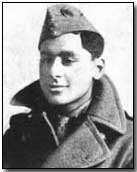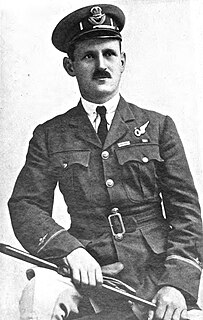This article needs additional citations for verification .(January 2016) (Learn how and when to remove this template message) |
Neville Bowker DFC (1918-2005) was the third-highest-scoring fighter ace from Southern Rhodesia during World War II. [1]
This article needs additional citations for verification .(January 2016) (Learn how and when to remove this template message) |
Neville Bowker DFC (1918-2005) was the third-highest-scoring fighter ace from Southern Rhodesia during World War II. [1]

The Distinguished Flying Cross (DFC) is the third-level military decoration awarded to officers, and since 1993 to other ranks, of the United Kingdom's Royal Air Force and other services, and formerly to officers of other Commonwealth countries, for "an act or acts of valour, courage or devotion to duty whilst flying in active operations against the enemy".

The Distinguished Flying Cross (DFC) is a military decoration of the United States Armed Forces. The medal was established on July 2, 1926 and is currently awarded to any persons who, after April 6, 1917, distinguish themselves by single acts of heroism or extraordinary achievement while participating in aerial flight. Both heroism and extraordinary achievement are entirely distinctive, involving operations that are not routine. The medal may be awarded to friendly foreign military members in ranks equivalent to U.S. Pay Grade of O-6 and below, in actual combat in support operations.

Group captain is a senior commissioned rank in many air forces. Group captain has a NATO rank code of OF-5, meaning that it ranks above wing commander, immediately below air commodore and is the equivalent of the naval rank of captain and the rank of colonel in other services.

Number 23 Squadron was a squadron of the Royal Air Force. Until October 2009, it operated the Boeing Sentry AEW1 Airborne Warning And Control System (AWACS) aircraft from RAF Waddington, Lincolnshire.

Indra Lal Roy, is the sole Indian World War I flying ace. While serving in the Royal Flying Corps and its successor, the Royal Air Force, he claimed ten aerial victories; five aircraft destroyed, and five 'down out of control' in just over 170 hours flying time, making him the first Indian flying ace.
Neville Frederick Duke, was a British test pilot and fighter ace of the Second World War. He was credited with the destruction of 27 enemy aircraft. After the war, Duke was acknowledged as one of the world's foremost test pilots. In 1953, he became holder of the world air speed record when he flew a Hawker Hunter at 727.63 mph (1,171.01 km/h) over Littlehampton.
Norman Leslie Robert Franks is an English militaria writer who specialises in aviation topics. He focuses on the pilots and squadrons of World Wars I and II.

No. 112 Squadron was a squadron of the Royal Air Force. It served in both the First World War and Second World War and was active for three periods during the Cold War. It is nicknamed "The Shark Squadron", an allusion to the fact that it was the first unit from any Allied air force to use the famous "shark mouth" logo on Curtiss P-40s.

No. 87 Squadron RAF was an aircraft squadron of the Royal Air Force during the First World War and Second World War.

Number 601 Squadron is a squadron of the RAF Reserves, based in London. The squadron battle honours most notably include the Battle of Britain, and the first Americans to fly in the Second World War were members of this squadron. Reactivated in 2017, it is a specialist squadron "tapping into the talents of leaders from industry, academia and research to advise and shape and inspire [the RAF]".

No. 615 Squadron was a unit of the British Auxiliary Air Force and later the Royal Auxiliary Air Force between 1937 and 1957.

No. 219 Squadron of the Royal Air Force was founded in 1918 and disbanded in 1957 after four separate periods of service. During the First World War it served as a coastal defence unit, and through most of the Second World War and the 1950s it operated as a night fighter air defence squadron. Three commanders of the squadron went on to be Chiefs of the Air Staff, two of the RAF and one of the Royal Pakistani Air Force.
Captain Ernest Charles Hoy DFC was a Canadian First World War flying ace, officially credited with 13 victories. He later pioneered airmail flight over the Canadian Rockies.

Lieutenant Lawrence Kingsley Callahan was a World War I flying ace credited with seventeen victories.
Lieutenant Carrick Stewart Paul DFC was a World War I flying ace from New Zealand. He was credited with five aerial victories in Palestine between May and August 1918 when flying a Bristol F.2 Fighter.
Lieutenant David John Weston was a British World War I flying ace credited with thirteen aerial victories. All of his wins were over enemy fighter planes.

Lieutenant Walter Noble was a World War I flying ace credited with twelve aerial victories.

Richard Nigel Cullen, was an Australian fighter ace of World War II. Serving with the Royal Air Force (RAF), he was credited with as many as sixteen aerial victories before being killed in action during the Battle of Greece. Born in Newcastle, New South Wales, Cullen was living in London and had already seen action in the Spanish Civil War when he joined the RAF in 1937. Following the outbreak of World War II, he served initially as a transport pilot with No. 267 Squadron in the Middle East before seeking reassignment to fighters. He was then posted to No. 80 Squadron, flying Gloster Gladiator biplanes, and claimed six Axis aircraft before the unit converted to Hawker Hurricanes. Nicknamed "Ape" due to his physical bulk, Cullen was awarded the Distinguished Flying Cross for destroying five enemy aircraft in a single sortie on 28 February 1941. He was credited with another four victories in the one engagement on 3 March; the next day, he was shot down and killed while on escort duty over Albania, by a Regia Aeronautica Fiat G.50bis, at age twenty-three.
Herbert Gilles Watson, was an Australian flying ace of the First World War credited with 14 aerial victories. He was the highest scoring New Zealand-born ace in the Australian Flying Corps, and the fourth highest scorer in his squadron.

Albert Gerald Lewis, was a South African fighter pilot and fighter ace who scored an ace in a day during the Battle of Britain, later being featured in a Life magazine article about the Battle of Britain.
| | This Zimbabwean biographical article is a stub. You can help Wikipedia by expanding it. |